Story and photos by Cathy Tuttle
People who bike every day are the folks who ground-truth poor maintenance. We intimately experience gutters filled with leaves and plastic bike lane wands broken in the same locations day after day. We see street trees dying, and giant potholes reappearing over and over on what look like war-torn streets. Then there are the piles of slippery leaves, illegible street signs, shattered glass, chunks of concrete, thorny brambles and so on. These hazards could injure or even kill someone. And they always make us uncomfortable.
Yet as important as it is, a well-maintained stretch of asphalt isn’t much of a photo op or ribbon-cutting opportunity. Maintenance just doesn’t have the same political oomph that “new” has. That means repairing, upgrading, and fixing streets is often overlooked, underfunded and understaffed.
The City of Portland wants to change that.
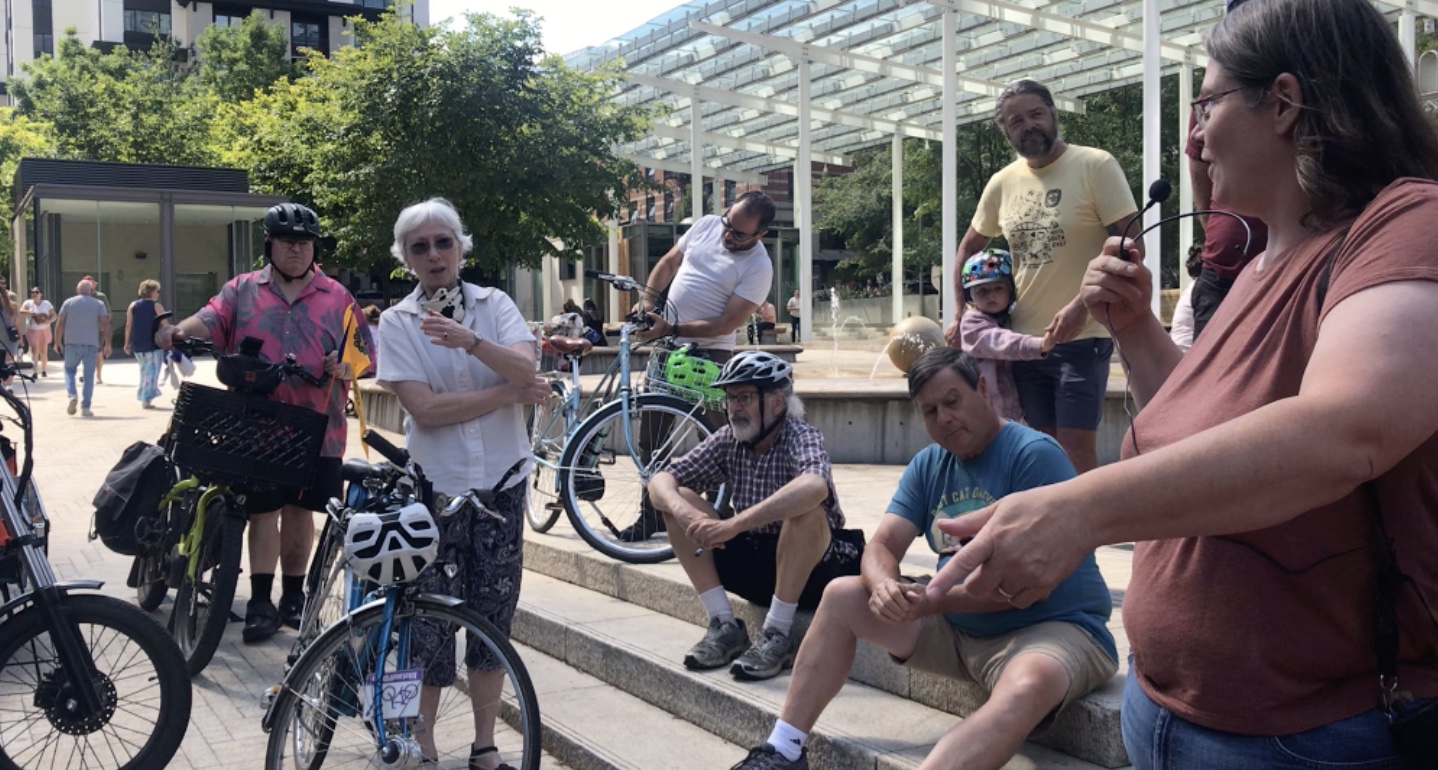
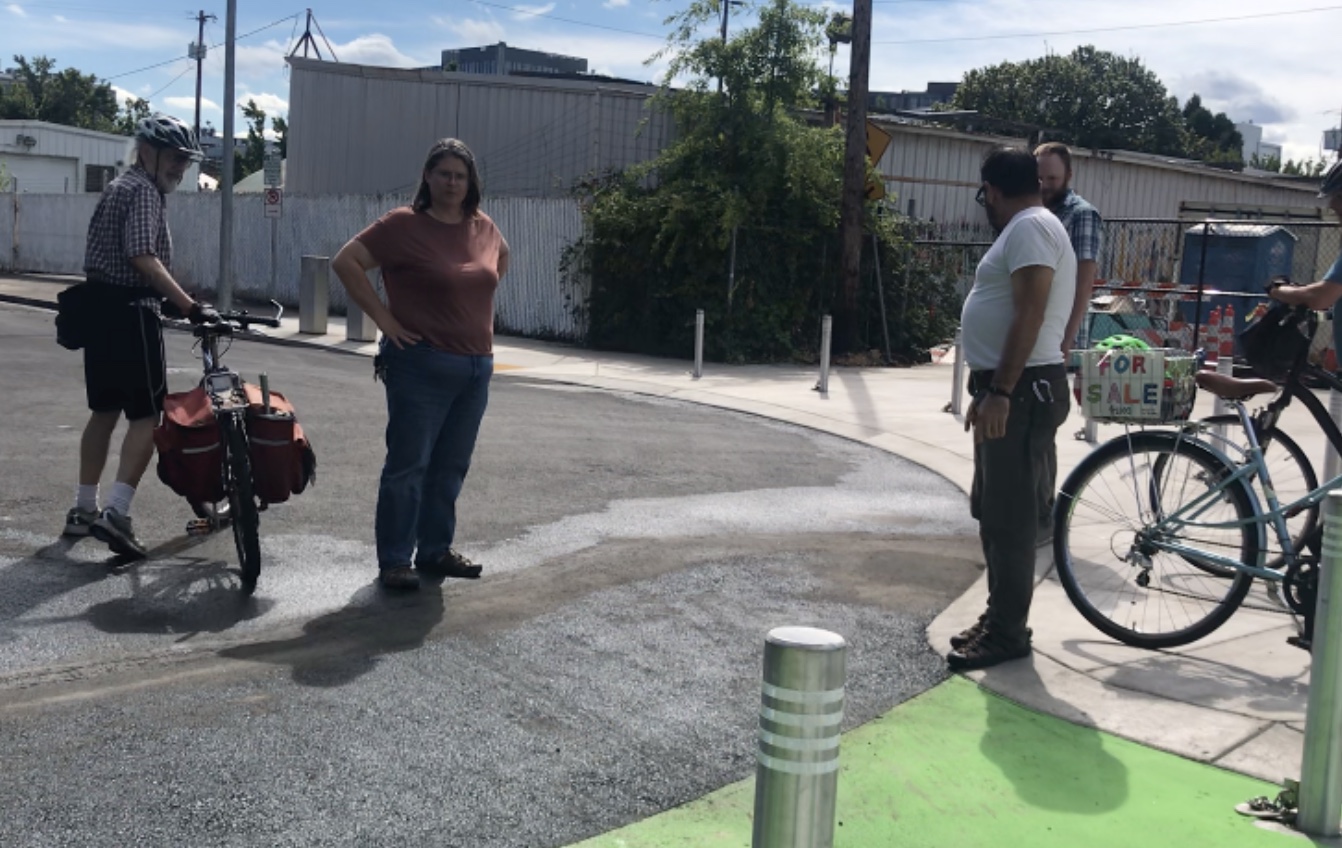
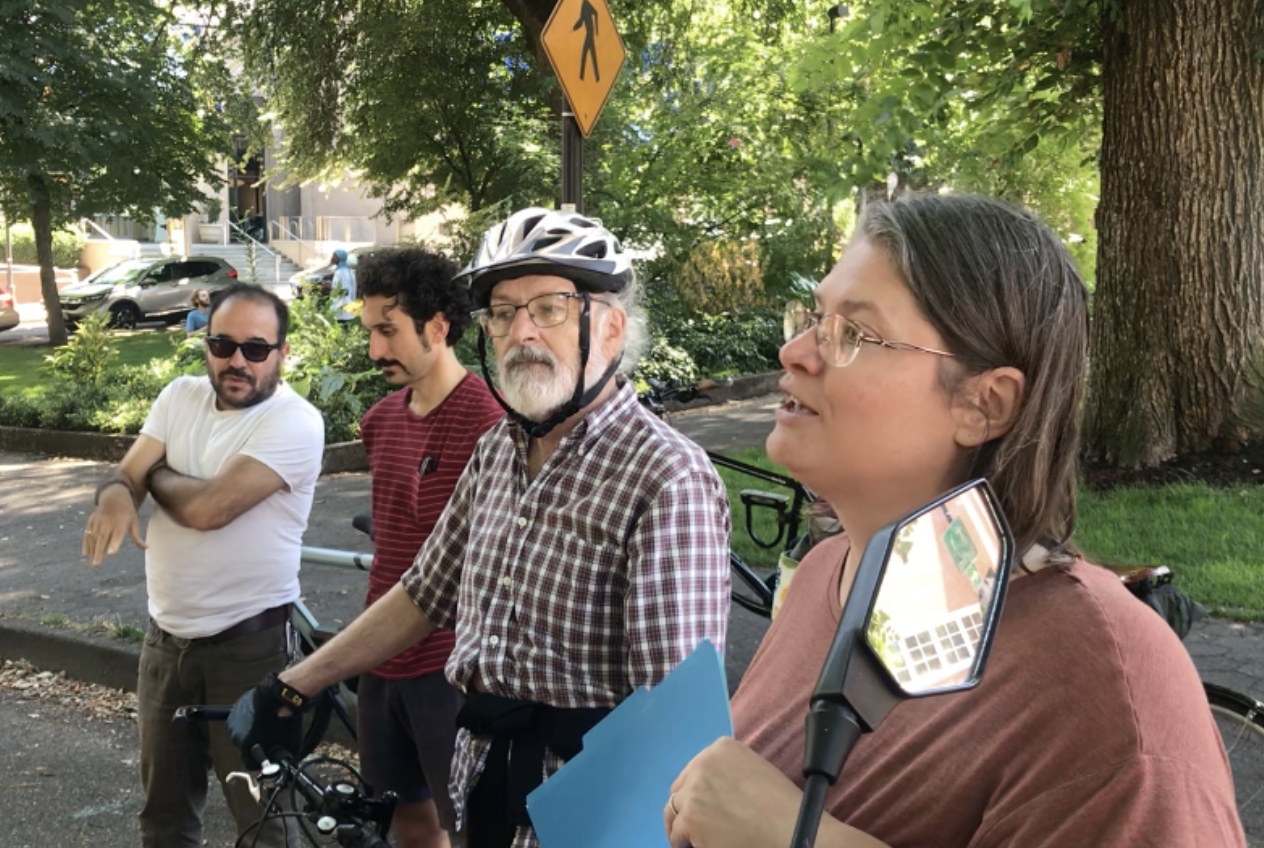
Portland Bureau of Transportation (PBOT) Maintenance and Operations Manager Jody Yates shared her time, knowledge, and experience with us on Friday August 26. Yates headlined the eleventh monthly BikeLoud PDX Policy Ride I’ve hosted, and her topic is what I’m personally most interested in as we retrofit our cities for the future. As a city planner and project manager, I have always been dedicated to building infrastructure we can maintain easily, rather than spending money on streets that need to be constantly rebuilt. Yates is too.
Jody Yates spent Friday afternoon riding in a three-wheeled electric pedicab piloted by Go By Bike founder and BikeLoud PDX Board President Kiel Johnson. Yates and the group who came to this Pedalpalooza ride talked for three hours about the materials under our feet (and wheels) and we barely scratched the surface.
PBOT is responsible for the maintenance of hundreds of millions of square feet of pavement – streets, sidewalks, bridges, staircases, plazas, and more. Though she started just in February 2022, Yates is up to speed on leading a maintenance and operations division of several hundred people. She brings a wealth of practical experience. A civil engineer for the past 25 years, Yates worked mainly for governments in Clackamas, Portland, and most recently in Beaverton. A thoughtful engineer, Yates was instrumental in getting programs started in creative street activation and rigorous asset management. Yates is putting significant energy into assessing where and how streets are failing, and smart ways to improve them.
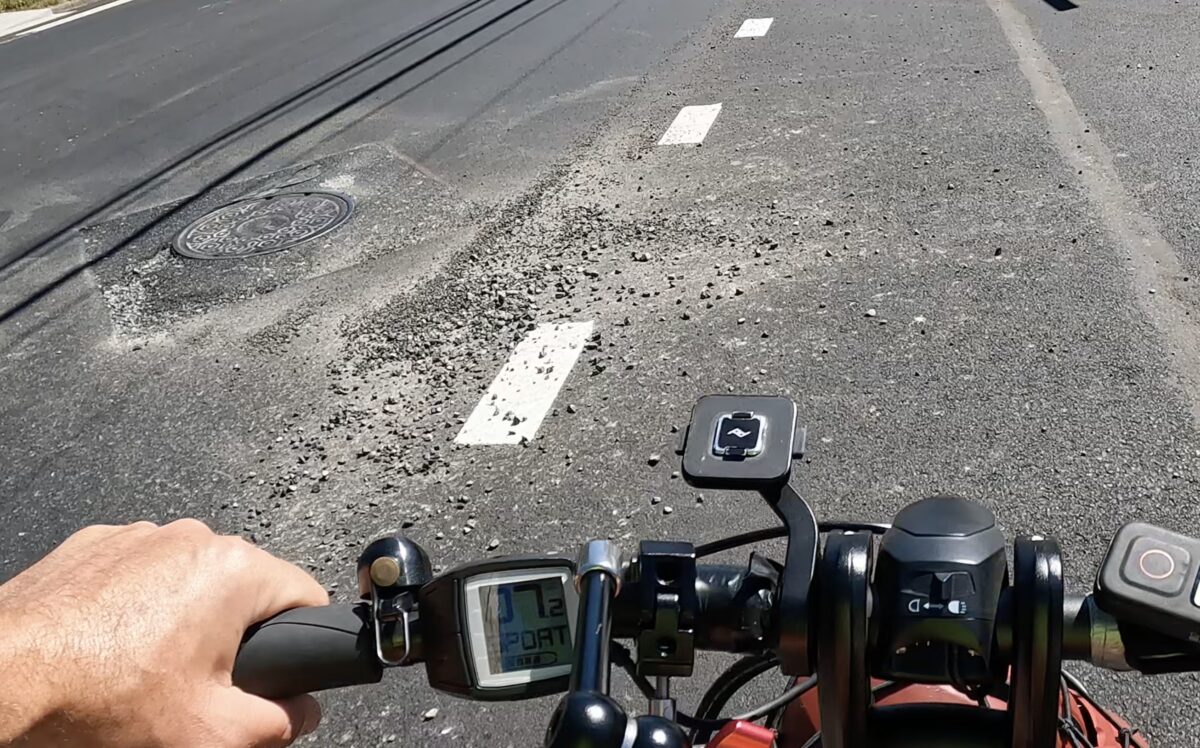
There are three main culprits of pavement destruction. In order of severity, streets are damaged by: poorly repaired utility trenches, extra heavy vehicles, and tree roots.
Though PBOT’s Maintenance and Operations Division does repairs and implements designs generated by other PBOT divisions, Yates talked about street maintenance as a design issue in and of itself, of how maintenance should be a first consideration and built into designs of new and upgraded streets. Streets need to be easy and affordable to take care of.
Yates said there are three main culprits of pavement destruction. In order of severity, streets are damaged by: poorly repaired utility trenches, extra heavy vehicles, and, far back in third place, by tree roots.
Utility trenches are made by gas, sewer, water, telecom, and other utilities. Yates called out telecom companies for doing a slapdash job repairing the roads they rip up when installing cables. Yates made the analogy of the process of utility cut and covers to a shirt that has been torn again and again; sometimes repaired carefully, but often too quickly. And all the tears and repairs eventually destroy the “fabric” of the street.
On our tour we looked at old streets cobbled with ballast blocks, pocked and pitted asphalt, concrete panels, and even some 100-year-old mixtures of paving material that still are intact because they hadn’t been cut into very much.
Road repaving can cost upwards of $6 million a mile, and with Portland on the hook for taking care of over 2,000 miles of roads, keeping what we have in good condition is very sensible.
Heavy vehicles can and do quickly destroy roads too. Transit stops are reinforced with heavy duty concrete panels instead of a few inches of asphalt that tends to quickly deform under heavy wheels. People walking and rolling do virtually no damage to streets, but cars also quickly wear off paint and thermoplastic, damage curbs and street furnishings, and wear down pavement too. A few divisions of PBOT staff under Yates are responsible for repairing damage to paint, furnishings, and other public street elements.
Street trees are vital to a healthy resilient city, but their roots can also lift pavement as they search for water and nutrients. Streets that have minimal or no car traffic — like the Park Blocks on the PSU campus — have plenty of room for mature street trees. Low-car streets also need much less maintenance to repair paving, paint, and street furnishings. Another reason it’s smart for us to invest in streets that prioritize people walking and wheeling? They never do as much damage to the right of way as cars do.
People who bike care about safety and comfort. That’s why road maintenance is so important to us. Smooth roads, clear sightlines, few conflict zones along routes including door zones and safe intersections. We need clear directional signs to guide us while biking. We need enough room to avoid obstacles and wide enough lanes to ride side by side together or to pass other people biking.
For all these reasons and more we look forward to learning more and working with Jody Yates and PBOT on these issues in the future!




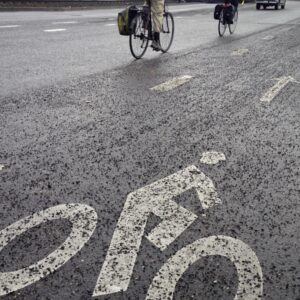
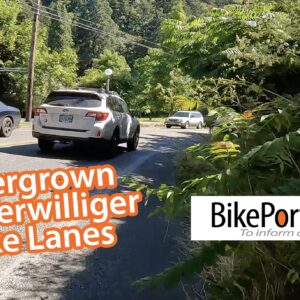
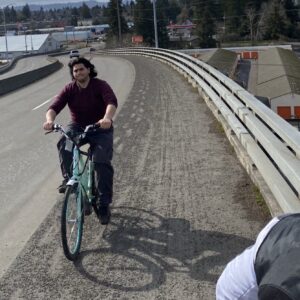
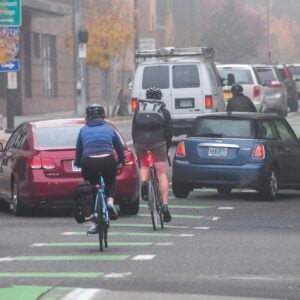
Thanks for reading.
BikePortland has served this community with independent community journalism since 2005. We rely on subscriptions from readers like you to survive. Your financial support is vital in keeping this valuable resource alive and well.
Please subscribe today to strengthen and expand our work.
I hope it came across that I really enjoyed biking with Jody Yates and also how important maintenance is to our safety and comfort as people who walk & bike for transportation.
PBOT has *80* open positions on the maintenance team.There’s a Job Fair to learn more about and fill those positions Oct 8 and 9 if your readers are looking for meaningful active work that improves the city.
This is a wonderful article, and yes, your enthusiasm for the topic and Jody Yates comes across. Thank you to you and JY.
Hi Cathy. Do you know if there’s information about these positions online? I couldn’t find anything.
I haven’t seen anything on-line info about the 80 vacant maintenance positions PBOT is trying to fill but would guess there’s a mix of carpenters, cleaners, inspectors, engineers, CAD specialists, day labor, and admin. There are variety of kinds of jobs needed to take care of the stuff that makes up 22% of the city. If you track down any more info, let BikePortland readers know.
And good luck with your job search!
Thank you, Cathy. I agree with Lisa; you wrote an excellent article! I learned a lot.
RE: As a city planner and project manager, I have always been dedicated to building infrastructure we can maintain easily, rather than spending money on streets that need to be constantly rebuilt. Yates is too.
I recently said that I think Portland has been lagging behind other metro regions in bold new urban infrastructure projects. That said, it’s encouraging to learn that not-so-shiny-PBOT-projects are being thoughtfully designed to consider long-term maintenance costs. My wife, who is a recently retired civil engineer, used to remind me why this is important.
Excellent recap and such a wonderful ride; thank you, Cathy! If you haven’t attended Cathy’s policy rides you’re missing out. These are extremely well thought out rides that help bring us together as we work toward a common goal: Saving the human species from destroying itself!
Cathy,
Thank you for organizing this ride and writing the article! Now we know ALL of the locate paint colors. Even pink!
Your daughter is just amazing! Bike Portland readers, Shawne’s 6-year-old daughter accurately identified the meaning of ALL of the street markings at one of our stops on the Jody Yates Policy Ride. Except pink.
Portland is in good hands with the next generation!
There are certainly more causes of pavement failure; several that come quickly to mind are use of studded tires, sinkholes caused by voids around utility piping, use of poor quality asphalt paving by contractors, defects caused by poor quality work associated with utility cuts, and plain old deferred maintenance.
You are right! There are so many ways pavement can fail which is why I found it interesting Yates highlighted the top three after 25 years of field experience.
Thinking outside of the pavement box would be a great way to address the backlog in maintenance too. It’s what forward-thinking cities are doing. Instead of paving and re-paving and repairing over and over, cities are creating useful heavy-duty paved corridors for transit, freight, emergency vehicles and services and shrinking the number streets wide enough to do donuts in.
Forgive me if my eyes are poor and I just missed where you and Jody talked about this issue in the article, but where is the urgency to maintain all of the “separated” bike infrastructure PBOT is building? (the lanes marked by plastic wands, especially).
On SW Maplewood Rd, the city created a lane separated by wands. It is now almost completely grown over, with weeds and brambles narrowing the lane to 1-2 feet in places, and tree limbs encroaching on the lane.
The problems of the lane on SW Beaverton-Hillsdale Hwy are well documented on BP.
I’m sorry but this article reads like a PBOT news release. I’d like some tougher questions about PBOT’s maintenance schedules and practices. I’m convinced they don’t maintain bike infrastructure b/c it’s *different* from what they do for cars and just too much of a culture shift.
Our Policy Ride on August 26 lasted for 3 hours and covered 5 miles, so there was a great deal I didn’t report on in my brief recap. Yates did talk to the group about vegetation management and about cleaning the protected bike lane (PBL) system. There are 2 mini-sweepers for PBLs. PBOT needs more sweepers and leaf haulers.
There is a lot of PBOT focus on leaf removal when large crews work night and day to clear streets in the fall. Spring and summer vegetation management seems more intermittent and its a big problem in protected bike lanes — especially in SW PDX. The group mentioned to Yates. She’s working to get vegetation control scheduled more proactively. Write to Yates, to CM Hardesty, to the PBOT Director Chris Warner if you have particular maintenance tasks that routinely are crying out for help. They won’t know just by reading the BikePortland comment section!
BikeLoud *is* working on a culture shift: holding the City accountable for its stated goal of 25% of all trips by bike by 2030. I hope you join us, come on future BikeLoud Policy Rides and ask questions! We need all voices.
PBOT did not even address overgrown vegetation on the recently completed Better Naito! There are 2 super dangerous locations: 1) at the connection to the Steel Bridge/waterfront trail- the blackberries or so tall on the south side of this intersection NB Naito users are obscured. Also, there is zero lighting there and it is super sketchy at night. 2) There are tall rose bushes on the north side of one of the CIty-owned parking lots that obscure the view of SB Naito user for people exiting the lot- this is an accident waiting to happen (I have 2 close calls already). This is brand new, major projects done under the auspices of creating a significant City route but many basic details were neglected. This is a lack of design skills- not doing informed research, and extremely poor construction management- not holding the contractor accountable to the City’s special provisions and contract documents. PBOT needs to do better.
I may have just missed it, but did we ever learn what the markings for ADA ramps/cutouts were?
Was there any discussion about training the PBOT project managers in charge of construction to hold contractors to the special provisions? Good designs are critical, but if projects are not installed correctly, they will not function well and maintenance will not be able to keep up. I see concrete, asphalt and paint installed out of spec all the time. A recent example was the Better Naito- the day it opened there were puddles in a few locations along the bike path! That installation should have never been accepted. I also noticed a crew out fixing the “bump” on the bike side of the Sullivans Crossing bridge (on the south side)- but they seemed to be leaving the ped half intact despite it being wildly out of ADA compliance.
You are right. I see what you see too. Large projects that are built by non-PBOT crews are often problematic, as are the more mundane utility cut and cover that are repaired by the utilities and telecom companies, rather than repaired by PBOT crews.
I don’t know what carrots and sticks PBOT has to address poor contractor installs and repairs. Maybe someone in PBOT leadership could answer? Anybody?
PBOT assigns a person to manage construction projects. They review submittals and conduct field observations. They are either too apathetic or not knowledgeable enough to reject work hat is incorrect or incomplete.
I’m sure that I speak for just about everyone reading this article; I want to scream every time that I see new pavement being torn up to install a new pipe or gas line, just months after the street was repaved. I have seen this everywhere that I have lived in Oregon…Portland, Eugene, and now Bend. It is clear that there is little, if any, co-ordination between City paving projects and utility company projects (or private housing developers) on the same street. I have asked a couple of City officials about this and their answer is always the same: we do let utility companies know when we are re-paving, and ask them to co-ordinate with us, but they rarely do. They are on a different project schedule then the City, and the City cannot legally require them to do their work at the same time.
sometimes it’s different city bureaus! we watched the fire dept rip up a 5-month-old intersection to put in a replacement hydrant. part of an ongoing 10-year plan that neither they nor water nor pbot coordinate on. in austin, there is a moratorium on digging up new pavement unless an emergency, with big fines. it can be done here, but when i asked i was met with shrugs from bureaus and councilmember staff…
A lot of the potholes aren’t reappearing over and over. They were just never filled.